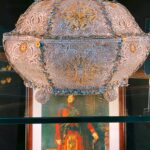The MacLeods of Scotland have much in common with the Malayalees of Kannur. In fact, they are practically cousins.
Think about it for a second. The traditional outfit of the MacLeod man involves a kilt. Malayalees wear mundu, which is pretty much the same thing with some regional adaptation. MacLeods get their pluck and carbs from haggis and tatties. Malayalees have their equivalence in botti and kappa. MacLeods sip whisky. Malayalees stay hydrated with patta. Both are loud, warm-hearted, hospitable spirits, known all over the world for their ability to make music with the Queen’s English.
All this—particularly the Kannur connection—came home to me when I visited the Dunvegan Castle on Skye. The castle has been the seat of the MacLeod chiefs for some 800 years, and among the treasures that visitors get to admire here is an exhibit marked Silver Fillgree Casket, brought home in the late 1700s by Major-General Norman MacLeod from Kannur in Kerala. I doubt if many people in Kannur would know what a silver fillgree casket is, and the MacLeods themselves do not appear to have quite yet worked out what the “beautiful ornate object” is, but there’s a spirited description of how it came to reside at Dunvegan.


Norman, who served with the East India Company, was the 23rd chief of the MacLeod clan. In 1783, his forces seized a town on the Malabar coast and “a great store of treasure of which the General’s share alone amounted to £130,000”. The exhibit was “given” to Norman by “the Bibi”, the ruler of the said town, who also offered to marry him. Norman—who was to later imprison his wife till her death—refused, saying he was already married, to which the Bibi is supposed to have responded, “That does not matter.”
The Bibi in question was Junumabe II of the Arakkal royal family, rulers of Kannur from 1545 to 1819. In 2005 the family trust opened up part of the palace to the public. I wonder how the Norman episode is presented to visitors there. No doubt the Arakkal version is ever so slightly different. It is possible there is an empty glass case somewhere in the museum displaying words such as “plunder” and “loot”, possibly under the title ‘Silver Spittoon, carried away by the British in 1783’.
That is the other thing the MacLeod and the Malayalee have in common. They don’t let a few facts stand in the way of a good story.

Previous Next